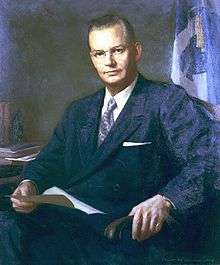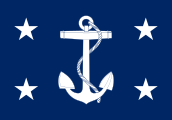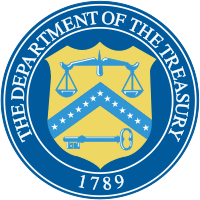Robert B. Anderson
Robert Bernard Anderson (June 4, 1910 – August 14, 1989) was an American administrator and businessman. He served as the Secretary of the Navy between February 1953 and March 1954. He also served as the Secretary of the Treasury from 1957 until 1961, and was one of President Eisenhower's closest confidants.[1] Two years before his death from cancer, he was disbarred for illegal banking operations and tax evasion.
Robert B. Anderson | |
|---|---|
 | |
| 56th United States Secretary of the Treasury | |
| In office July 29, 1957 – January 20, 1961 | |
| President | Dwight D. Eisenhower |
| Preceded by | George M. Humphrey |
| Succeeded by | C. Douglas Dillon |
| 5th United States Deputy Secretary of Defense | |
| In office May 3, 1954 – August 4, 1955 | |
| President | Dwight D. Eisenhower |
| Preceded by | Roger M. Kyes |
| Succeeded by | Reuben B. Robertson Jr. |
| 4th United States Secretary of the Navy | |
| In office February 4, 1953 – March 3, 1954 | |
| President | Dwight D. Eisenhower |
| Preceded by | Dan A. Kimball |
| Succeeded by | Charles Thomas |
| Member of the Texas House of Representatives from the 99th district | |
| In office January 10, 1933 – September 11, 1933 | |
| Preceded by | John Holland Veatch |
| Succeeded by | Edgar Emmett Hunter |
| Personal details | |
| Born | Robert Bernard Anderson June 4, 1910 Burleson, Texas, US |
| Died | August 14, 1989 (aged 79) New York City, New York, US |
| Political party | Democratic (Before 1956) Republican (1956-1989) |
| Spouse(s) | Ollie Rawlins
( m. 1935; died 1987) |
| Children | 2 |
| Education | Southwestern University Weatherford College (BA) University of Texas at Austin (LLB) |
| Signature | |
Early life
Anderson was born in Burleson, Texas on June 4, 1910, to Robert Lee Anderson and his wife Elizabeth Haskew "Lizzy" Anderson. He was a high school teacher prior to entering the University of Texas Law School, from which he graduated in 1932. He thereafter engaged in political, governmental, law and business activities in the state of Texas.
State government service
Upon leaving the University of Texas School of Law in 1932, Anderson soon became an Assistant Attorney General for the State of Texas where he worked in 1933-1934. By 1934, he moved onward to become a State of Texas Tax Commissioner.
By 1939-1940, Anderson pursued opportunities within the private sector; he and two other partners purchased the City of Austin-based KTBC radio station from the Texas Broadcasting Company. In 1943, not able to increase KTBC's broadcasting power from the Federal Communications Commission (FCC), the three partners sold KTBC to Lady Bird Johnson, wife of then-Representative and future President Lyndon B. Johnson.
Marriage and children
Anderson married Ollie Mae Rawlins on April 10, 1935. The couple had two sons, Gerald Lee and James Richard. The Anderson family later moved to Cleburne, Texas. Ollie Anderson died in Greenwich, Connecticut of Alzheimer disease on May 31, 1987.
Federal government service
During his time as Navy Secretary, he ended the last formal vestiges of racial segregation in the Navy and advocated the force levels and technological advances necessary to maintain a flexible defense strategy. In May 1954, Anderson left his Navy post to become Deputy Secretary of Defense. He received the Medal of Freedom in 1955. From 1957 to 1961, he served as Eisenhower's Secretary of the Treasury.
Eisenhower was particularly impressed by Anderson's abilities, believing him to be more than capable of being president himself, and named him as one of his leading choices to be his running mate in 1956 if Vice-President Richard Nixon have accepted Eisenhower's recommendation to leave the vice-presidency to serve as Secretary of Defense.[2] However, Nixon opted to remain on the ticket with Ike. As 1960 approached, although Eisenhower acknowledged that Nixon certainly had the Republican presidential nomination sewn up, Eisenhower privately pressed Anderson to enter the primaries and to challenge Nixon, but Anderson declined. Once Nixon was nominated, Eisenhower suggested that he select Anderson as his running mate, but Nixon chose Henry Cabot Lodge Jr. instead.
Eisenhower said Anderson "is just about the ablest man that I know, He would make a splendid President."[3]
In 1959, as Secretary of the Treasury, Anderson supported the creation of the International Development Association, after pressure from then-Senator Mike Monroney (D-Oklahoma).[4]
Private business and death
After leaving office, Anderson was active in business, investment and banking affairs, and, during the 1960s, carried out diplomatic missions on behalf of President Lyndon B. Johnson, including many trips to Cairo to confer with Egyptian President Gamal Abdel Nasser in the wake of the 1967 Six-Day War.[5]
Anderson owned the Anderson group, where he had business interests in a number of international projects. Anderson was a director on the Hong Kong Resort Company board. He had a casino investment with Edward Wong Wing-cheung, founder of HKR.[6]
Anderson's career ended in personal suffering. He was hospitalized several times for alcoholism. He illegally operated the Commercial Exchange Bank of Anguilla, British West Indies, which had an unlicensed New York branch office. The bank lost $4.4 million and several investors lost their life savings in the mid 1980s including record producer Ethel Gabriel.[7] The bank also laundered large amounts of cash for drug traffickers. In 1987, Anderson pleaded guilty to criminal violations of the banking laws and to tax evasion, and was sentenced to prison.[8] The Supreme Court of New York Appellate Division, in disbarring Anderson from the practice of law, called his disbarment "a sad but we think necessary end to the legal career of one who has in times less beclouded by poor and corrupt judgment served his country in high office as Secretary of Treasury, Deputy Secretary of the Navy and as Special Ambassador to Panama during the Panama Canal negotiations."[9]
Anderson died of throat cancer following his cancer surgery in New York City on August 14, 1989. He was buried in Rose Hill Cemetery in Cleburne, Texas.
References
- Ambrose, Stephen E. (1990). Eisenhower: Soldier and President. Simon & Schuster. p. 501. ISBN 0-671-74758-4.
- Remarks by Secretary of the Treasury, Robert B. Anderson, at Treasury-industry Top Management Meeting for Payroll Savings Program. 1960.
- Ambrose, Stephen (September 28, 1984). Eisenhower the President. 4302: Simon & Schuster. ISBN 978-0671499013.CS1 maint: location (link)
- Kapur et al, 1997, The World Bank: Its First Half Century, Volume 1, Washington DC: Brooklings Institution
- "Foreign Relations of the United States, 1964–1968, Volume XIX, Arab-Israeli Crisis and War, 1967 – Office of the Historian". history.state.gov. Retrieved 11 April 2018.
- US Department of State diplomatic cables, 17 August 1977
- "Award Covers Some Funds Lost by Ex-U.S. Treasurer". Los Angeles Times. 1989-05-30. ISSN 0458-3035. Retrieved 2019-06-05.
- "Former Treasury Secretary Faces Prison : Robert B. Anderson, 76, Pleads Guilty to Tax Evasion, Bank Fraud". Los Angeles Times. 1987-03-27. ISSN 0458-3035. Retrieved 2019-06-05.
- Matter of Anderson, 142 A.D.2d 498, 536 N.Y.S.2d 765 (January 12, 1989).
External links
| Wikimedia Commons has media related to Robert Bernard Anderson. |
- Papers of Robert B. Anderson, Dwight D. Eisenhower Presidential Library
- Robert B. Anderson at Find a Grave

| Government offices | ||
|---|---|---|
| Preceded by Dan A. Kimball |
United States Secretary of the Navy February 4, 1953 – March 3, 1954 |
Succeeded by Charles S. Thomas |
| Political offices | ||
| Preceded by Roger M. Kyes |
United States Deputy Secretary of Defense 1954–1955 |
Succeeded by Donald A. Quarles |
| Preceded by George M. Humphrey |
U.S. Secretary of the Treasury Served under: Dwight D. Eisenhower 1957–1961 |
Succeeded by C. Douglas Dillon |





